
Mitte is the first and most central borough of Berlin. The borough consists of six sub-entities: Mitte proper, Gesundbrunnen, Hansaviertel, Moabit, Tiergarten and Wedding.

Charlottenburg is a locality of Berlin within the borough of Charlottenburg-Wilmersdorf. Established as a town in 1705 and named after Sophia Charlotte of Hanover, Queen consort of Prussia, it is best known for Charlottenburg Palace, the largest surviving royal palace in Berlin, and the adjacent museums.

Tiergarten is a locality within the borough of Mitte, in central Berlin (Germany). Notable for the great and homonymous urban park, before German reunification, it was a part of West Berlin. Until Berlin's 2001 administrative reform, Tiergarten was also the name of a borough (Bezirk), consisting of the current locality (Ortsteil) of Tiergarten plus Hansaviertel and Moabit. A new system of road and rail tunnels runs under the park towards Berlin's main station in nearby Moabit.

Moabit is an inner city locality in the borough of Mitte, Berlin, Germany. As of 2016, around 77,000 people lived in Moabit. First inhabited in 1685 and incorporated into Berlin in 1861, the former industrial and working-class neighbourhood is fully surrounded by three watercourses, which define its present-day border. Between 1945 and 1990, Moabit was part of the British sector of West Berlin and directly bordered East Berlin.
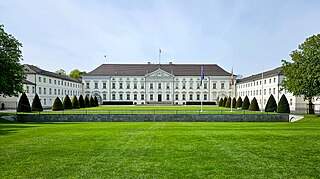
Bellevue Palace, located in Berlin's Tiergarten district, has been the official residence of the president of Germany since 1994. The schloss is situated on the banks of the Spree river, near the Berlin Victory Column, along the northern edge of the Großer Tiergarten park. Its name – the French for "beautiful view" – derives from its scenic prospect over the Spree's course.
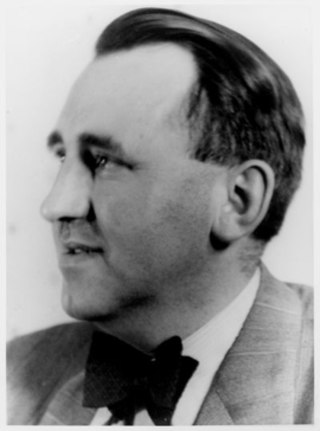
Georg Groscurth, was a German medical doctor and member of the resistance to Nazism in the time of the Third Reich.

Peter Joseph Lenné was a Prussian gardener and landscape architect. As director general of the Royal Prussian palaces and parks in Potsdam and Berlin, his work shaped the development of 19th-century German garden design in the Neoclassical style. Laid out according to the principles of the English landscape garden, his parks are now World Heritage Sites.

The Soviet War Memorial is one of several war memorials in Berlin, the capital city of Germany, erected by the Soviet Union to commemorate its war dead, particularly the 80,000 soldiers of the Soviet Armed Forces who died during the Battle of Berlin in April and May 1945.

Friedrich August Stüler was an influential Prussian architect and builder. His masterpiece is the Neues Museum in Berlin, as well as the dome of the triumphal arch of the main portal of the Berliner Schloss.

The battle in Berlin was an end phase of the Battle of Berlin. While the Battle of Berlin encompassed the attack by three Soviet fronts to capture not only Berlin but the territory of Germany east of the River Elbe still under German control, the battle in Berlin details the fighting and German capitulation that took place within the city.
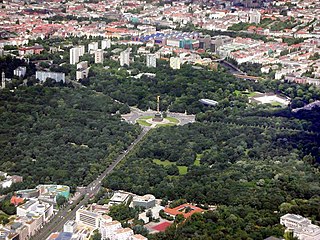
The Tiergarten is Berlin’s most popular inner-city park, located completely in the district of the same name. The park is 210 hectares in size and is among the largest urban gardens of Germany. Only the Tempelhofer Park and Munich's Englischer Garten are larger.

Volkspark Friedrichshain is a large urban park on the border of the Berlin neighborhoods of Friedrichshain and Prenzlauer Berg. The oldest public park in Berlin, at 52 hectares, it is also the fourth-largest, after Tempelhofer Park, Tiergarten, and Jungfernheide.
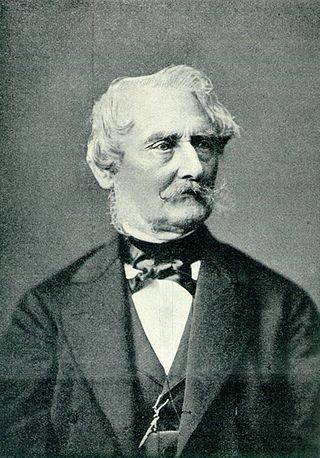
Johann Heinrich Strack was a German architect of the Schinkelschule. His notable works include the Berlin Victory Column.

Louis Sussmann-Hellborn, also spelled Ludwig Sussman Hellborn, was a German sculptor, painter, art collector and contractor.
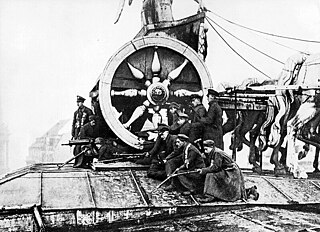
The Spartacist uprising, also known as the January uprising, was an armed uprising that took place in Berlin from 5 to 12 January 1919. It occurred in connection with the November Revolution that broke out following Germany's defeat in World War I. The uprising was primarily a power struggle between the Social Democratic Party of Germany (SPD) led by Friedrich Ebert, which favored a social democracy, and the Communist Party of Germany (KPD), led by Karl Liebknecht and Rosa Luxemburg, which wanted to set up a council republic similar to the one established by the Bolsheviks in Russia. In 1914 Liebknecht and Luxemburg had founded the Marxist Spartacus League, which gave the uprising its popular name.

Schlossbrücke is a bridge in the central Mitte district of Berlin, Germany. Built between 1821 and 1824 according to plans designed by Karl Friedrich Schinkel, it was named after the nearby City Palace (Stadtschloss). The bridge marks the eastern end of the Unter den Linden boulevard.

Fritz Schloß Park is a park in Berlin in the district of Moabit, located in the borough of Mitte.

Park Glienicke, is an English landscape garden in the southwestern outskirts of Berlin, Germany. It is located in the locality of Wannsee in the Steglitz-Zehlendorf borough. Close to Glienicke Bridge the park is open to the general public. The park is part of the UNESCO World Heritage Site Palaces and Parks of Potsdam and Berlin. Within the ensemble it is one of the five main parks, the others being Sanssouci Park, New Garden, Babelsberg Park and Peacock Island (Pfaueninsel). Regarding diversity in gardening styles within the Potsdam park ensemble Park Glienicke is only superseded by Sanssouci Park. Furthermore, it is a park especially characterized by one personality due to the intense involvement of Prince Charles of Prussia. The park covers approximately 116 hectares

Zelimkhan Sultanovich Khangoshvili was an ethnic Chechen Georgian who was a former platoon commander for the Chechen Republic of Ichkeria during the Second Chechen War, and a Georgian military officer during the 2008 Russo-Georgian War. Later on, he allegedly turned into a useful source of information for the Georgian Intelligence Service by identifying Russian spies and jihadists operating on domestic and foreign soil to Georgian intelligence agents. Khangoshvili was considered a terrorist by the Government of the Russian Federation, the Federal Security Service, and wanted in Russia. On 23 August 2019, Khangoshvili was assassinated in Kleiner Tiergarten, a park in Berlin by FSB operative Vadim Krasikov.

History of the Berliner Pferdebahnhof






















